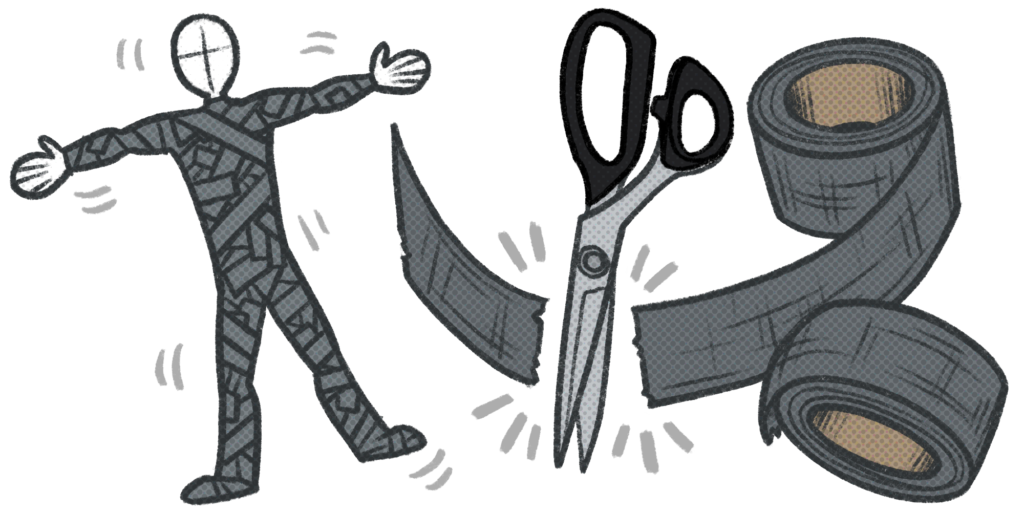
You will need to make and send me a Duct Tape Dummy. A DTD is a mannequin of your own body made with duct tape and allows me to make your costume tailored to your body.
If your DTD is defective and rips (badly made or with cheap materials), you will be charged for the time I spent fixing it. To make sure your DTD is correct, please read all the info on this page!
Warning: this mannequin represents your body at a certain point in time and the costume will be based onto its measurements. If you gain or lose weight before receiving your costume, I will not be responsible for any size difference.
It may be obvious, do not do your DTD while intoxicated, be it you or your helpers.
Make sure to have a plan prepared with your helpers if something unexpected happens in the middle of making the DTD: they must be ready for anything for your safety, such as cutting the DTD prematurely to get you out or carry you if you need to evacuate the premises in an emergency. The DTD manufacturing process can be dangerous in the event of an emergency if you are not prepared for it.
If you have a medical history that could be dangerous in the context of making a DTD, seek your doctor’s advice beforehand and keep your assistants informed of the risks.
Materials
You will need the following things to make your DTD:
– A painter’s suit OR a set of clothes (long-sleeved t-shirt and long pants close to the body, a pair of socks) that you are okay with cutting through.
– 3 to 4 rolls of 50 meters of duct tape, generally recognizable by its silver color
– Paper towels
– Scissors that cut well
– 1 permanent marker
– 2 brooms
– One or several people you trust to assist you
– A fan if you are making your DTD in hot weather
If you plan to wear a cooling vest under your future costume, you can wear it under your painter’s coveralls while making the DTD so that the mannequin takes into account your measurements plus the measurements of the vest.
How to make it more bearable
A DTD making session can take between two and four hours depending on pace and on the number of people helping you.
You will be standing up for the entire session, which will be tiring and uncomfortable. You can use the two brooms to keep your arms parallel to the ground without getting too tired.
The more the session progresses, the less freedom of movement you will have because you will end up almost completely wrapped in tape.
Your helpers’ role will be to tape you down to create the dummy, as well as help you get as comfortable as possible and help with drinks and snacks.
It is strongly recommended to plan ahead of the DTD session as much as possible and to think of things to pass the time as well as what to eat and drink.
Having made two DTDs of my body in the past and helped make other people’s, I recommend that you agree on a movie or series to watch during the session, or a playlist of karaoke or blindtest. Prepare your favorite snacks, savory or sweet according to your preferences and those of your helpers, as well as a straw to allow you to drink easily.
Obviously, go to the toilet before starting on your DTD.
Fabrication
The first thing you need to know for a quality DTD is to overlap the pieces of tape so that they form crosses, not parallel strips. By making the pieces are criss-crossed, the DTD will be very sturdy because the gripping surface of the strips between themselves will be bigger.
A DTD consisting only of parallel bands will be very likely to tear later on.
For the process, I advise following the video tutorial by Mischief Makers below.
Here are some details on what I personally prefer you to do when preparing your DTD for ordering from Tapapat Creations (in addition to what is shown in the tutorial above):
Cover down to half of the foot so that the heel is included in the DTD. You can cover the entire foot as well if you wish.
Cover up to half of the throat so that a part of the neck is visible on the DTD.
When it comes time to cover your arms you can hold on to the handle of the brooms, one in each hand to keep your arms spread.
It is important to keep your arms parallel to the ground, and keep your feet slightly apart (feet aligned with the shoulders).
Leave the painter’s suit zipper functional: This will speed up your exit from the DTD and make it easier for me when I need to stuff your dummy in my studio.
As explained in Mischief Makers’ tutorial, be careful to follow the curves of the body closely.
The armpits and crotch in particular are areas of movement where you will need to be careful not to have a gap between the body and the tape.
Be careful when cutting the DTD not to cut the person’s skin. If you’re afraid of making a mistake, you can take a credit card type card or a plastic ruler that you slide between the person’s skin and the DTD when cutting. By resting the tip of the scissors against the ruler, you will ensure that you do not grab the person’s skin when cutting.
